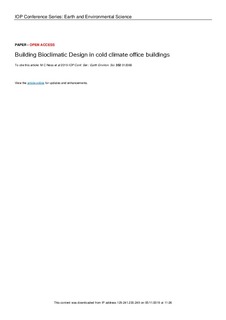| dc.contributor.author | Ness, Maria Coral Albelda-Estellés | |
| dc.contributor.author | Andresen, Inger | |
| dc.contributor.author | Kleiven, Tommy | |
| dc.date.accessioned | 2019-11-18T09:48:11Z | |
| dc.date.available | 2019-11-18T09:48:11Z | |
| dc.date.created | 2019-11-15T15:29:05Z | |
| dc.date.issued | 2019 | |
| dc.identifier.citation | IOP Conference Series: Earth and Environmental Science (EES). 2019, 352 (1), 012066-?. | nb_NO |
| dc.identifier.issn | 1755-1307 | |
| dc.identifier.uri | http://hdl.handle.net/11250/2628928 | |
| dc.description.abstract | Building Bioclimatic Design (BBCD) understands architecture as a filter between outdoor climate and indoor comfort. This way, it encourages the exploitation of freely available climatic resources, before adding any HVAC system. Therefore, BBCD represents a fundamental strategy for improving energy efficiency in buildings. The climate / comfort comparison in building design determines the passive strategies that are most suitable for a specific climatic context, as well as the level of architectural complexity. In cold climates, it would suggest the use of compact shapes and extremely airtight and insulating envelopes, in order to minimize heat losses while maximizing solar heat gains. However, when combined with high internal gains, these measures might cause overheating problems in the warm seasons. That is the case of office buildings, where cooling equipment is included as default even in cold climates, drastically increasing their energy consumption. It is therefore becoming a necessity to consider here the adoption of passive cooling strategies once identified with warmer climates. The aim of this research is to explore how the theories and tools for BBCD could be applied to cold climate office buildings. In order to study the effect of the different climatic contributors, we will use Building Performance Simulation to analyse relevant cases with EnergyPlus (in combination with DesignBuilder). This will in turn help drawing suggestions on how to adapt the Building Bioclimatic Chart (BBCC) for its application to cold climate office buildings in practice. It is well known that the earlier we apply the measures for energy efficiency, the greater their effect and with higher degree of integration. The BBCC is used in the pre-design phase to determine the most suitable passive strategies for climate adaptation and control, informing the design as early as possible along the process. This study can contribute to the development of zero emission neighbourhoods in cold climates, by improving the energy efficiency of their buildings. Additionally, it complements the existing research in BBCD by extending its application to cold climates and office buildings. | nb_NO |
| dc.language.iso | eng | nb_NO |
| dc.publisher | IOP Publishing | nb_NO |
| dc.rights | Navngivelse 4.0 Internasjonal | * |
| dc.rights.uri | http://creativecommons.org/licenses/by/4.0/deed.no | * |
| dc.title | Building Bioclimatic Design in cold climate office buildings | nb_NO |
| dc.type | Journal article | nb_NO |
| dc.type | Peer reviewed | nb_NO |
| dc.description.version | publishedVersion | nb_NO |
| dc.source.pagenumber | 012066-? | nb_NO |
| dc.source.volume | 352 | nb_NO |
| dc.source.journal | IOP Conference Series: Earth and Environmental Science (EES) | nb_NO |
| dc.source.issue | 1 | nb_NO |
| dc.identifier.doi | 10.1088/1755-1315/352/1/012066 | |
| dc.identifier.cristin | 1748153 | |
| dc.description.localcode | Content from this work may be used under the terms of theCreative Commons Attribution 3.0 licence. Any further distribution of this work must maintain attribution to the author(s) and the title of the work, journal citation and DOI. Published under licence by IOP Publishing Ltd | nb_NO |
| cristin.unitcode | 194,61,55,0 | |
| cristin.unitname | Institutt for arkitektur og teknologi | |
| cristin.ispublished | true | |
| cristin.fulltext | original | |
| cristin.qualitycode | 1 | |

